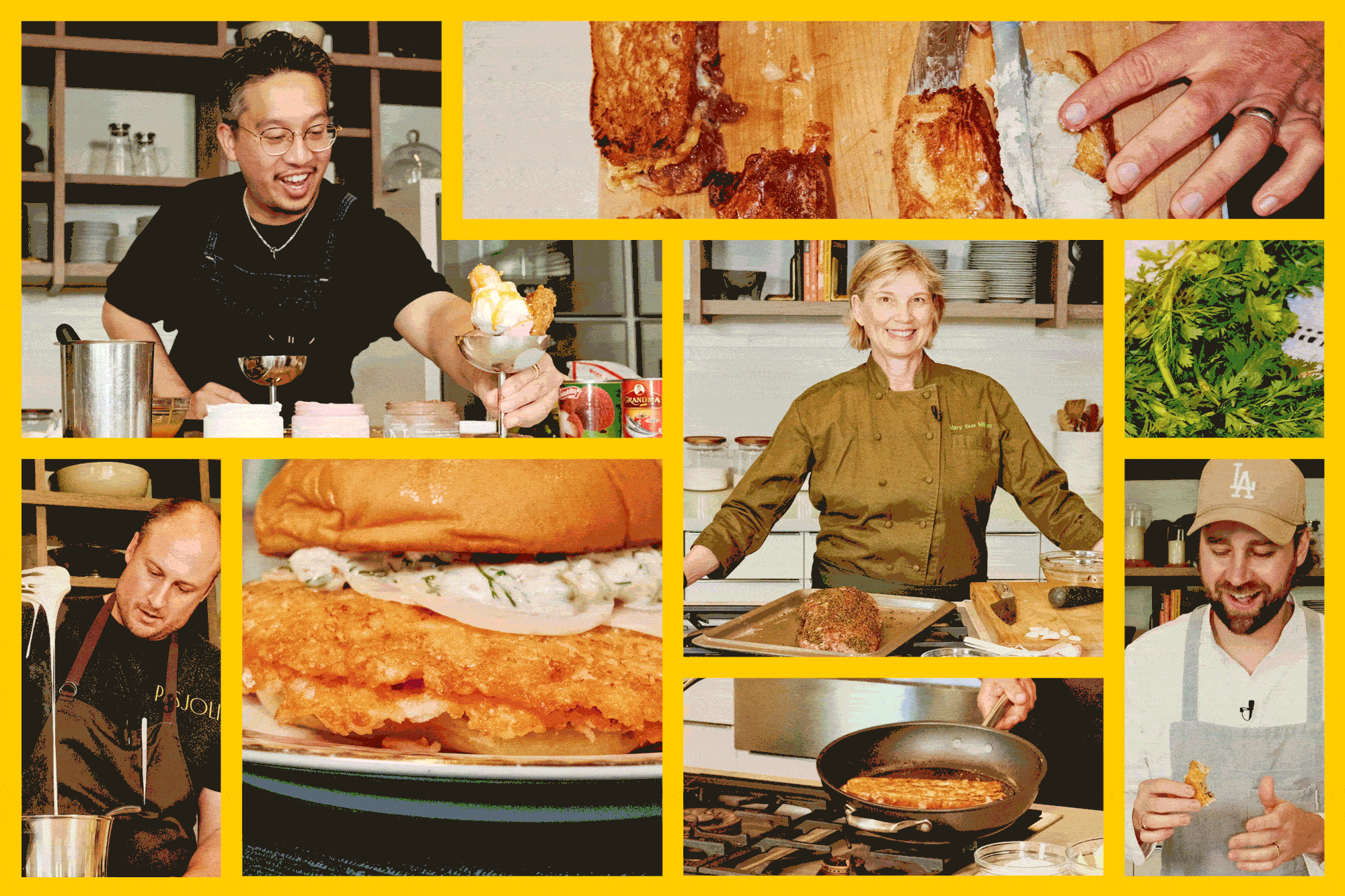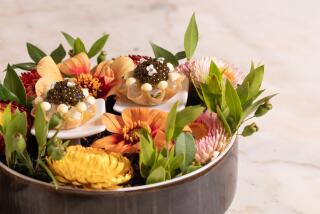Jonathan Waxman shares his wealth
Although Jonathan Waxman has spent the last 30 years cooking up an impressive résumé -- cutting his teeth at Chez Panisse with Alice Waters, helming Michael’s in Santa Monica during its heyday, mentoring a young Bobby Flay -- he had not, until now, given us a cookbook. It’s surprising, considering how influential he’s been (he’s often credited with bringing California cuisine to New York, at his restaurant Jams in the ‘80s) and how many high-profile names he could drop along with the occasional cutlery.
But open Waxman’s debut book, “A Great American Cook: Recipes From the Home Kitchen of One of Our Most Influential Chefs,” and the surprise is replaced by a kind of gratitude. The book reads like a catalog of Waxman’s illustrious career, and it’s a mouthwatering one. Waxman culls old favorite recipes from his days at Chez Panisse and Michael’s. He also includes dishes from the restaurants he’s opened on both coasts in the years since: Napa Valley’s erstwhile Table 29 and West County Grill in Sebastopol, Calif., which opened this past spring; in New York, Jams and Bud’s, both now closed, and Barbuto, his 3-year-old bistro in the West Village. (Clearly what Waxman’s been doing instead of writing cookbooks is opening restaurants.)
Technique, timing needed
Good cookbooks, not unlike some of the recipes in them, take time to make. Perhaps because Waxman has spent so many decades in professional kitchens, his book is not for kitchen novices: Its pages often rely heavily on technique, precision timing and painstakingly gathered ingredients. But for those with confidence and some experience in the kitchen, it’s a stately book, with a range of dishes and a depth that, for the patient and skilled cook, makes it well worth the wait. However, because there are problems in a number of the recipes, it can also be frustrating.
The book feels as if it’s been written by someone who’s been writing a lot of menus too. This is no coffee-table art book -- though there are plenty of beautifully shot, nicely lighted photographs by John Kernick -- but rather a practical catalog of the dishes Waxman has cooked over the years, from the impressive red pepper pancakes with fresh corn and caviar he created for Alice Waters to the rustic bacon-tomato-scallion pizza he now cooks at home for his three young kids.
This range is the most appealing aspect of the book. Because even though Waxman gives us “recipes from the home kitchen” (more than 100 of them), many of those that originated in his restaurants are far more involved than they seem.
The red pepper pancakes, for example, require eggs that are separated, whites beaten, batter rested. The potatoes for the French fries are first soaked overnight, then blanched in hot oil, then chilled, then refried in hotter oil. The apples, all four of them, for the apple-corn fritters must be cut into precise quarter-inch cubes (a macedoine cut; I felt as if I was being put through my paces at culinary school). The poblano-stuffed chicken breasts call for not just any chicken breasts, but ones with the wing joint still attached -- an old-fashioned airline breast -- something you need to ask your butcher to do for you, if you’re not handy at fabricating (or precisely cutting up) poultry at home.
After such cheffy tribulations, it feels like a reprieve to get an easy recipe, such as the one for a simple grilled cheese sandwich with sautéed onions, goat cheese and wilted leftover salad greens he makes for a restaurant family meal. The sandwich was wonderful, perfectly balanced, redolent of the arugula, cress and romaine I used, the filling gently spiked with a dash of pepper flakes. Or something he really does make at home, such as a straightforward and kid-friendly pizza topped with diced tomatoes, raw bacon, chopped green onions and a dusting of Parmesan. Sure, you first have to make the pizza dough, but it’s a good one and well worth having in your repertoire.
Most of the more elaborate recipes I tested are worth the effort too. Waxman’s dishes are distinguished by their detailed flavor profiles, and he’s brilliant at layering and riffing. (Not for nothing was he a jazz musician before he traded in the trombone, in his 20s, for a chef’s toque.)
This means multiple ingredients are often cooked separately, as they are in a wild mushroom salad Waxman created at Michael’s in Santa Monica. Croutons, pine nuts, mushrooms and vinaigrette all get individual treatment before the final assembly. This all happens incrementally, painstakingly, because Waxman knows each ingredient operates differently, and only by attention to each individual flavor can the whole function as he wishes it to. The result is marvelous, a subtle combination of terrific flavor, textures and colors.
Maybe because he’s used to giving instructions to trained chefs, or maybe because jazz musicians expect a level of shrewd improvisation, Waxman assumes we’ll know how to properly season his recipes. “Season with salt and pepper” is a very casual direction, especially when repeated often within the same recipe. How much salt? How much pepper? Too little can be corrected, but the cumulative burden of too much can wreck a dish as easily as not having an instant-read or deep-fry thermometer can in this cookbook.
Some technical issues also can prove problematic. The instructions for the red pepper pancakes, for example, stipulate that one tablespoonful of batter makes a 2 1/2 - to 3-inch pancake, and that the recipe will yield eight pancakes. In fact, one tablespoonful made 2-inch pancakes, 24 of them. (We’ve adapted the recipe to correct the problem.)
And in the recipe for wild mushroom salad, croutons are tossed in a bowl with chopped rosemary and raw minced garlic, but Waxman neglects to mention whether the considerable amount of garlic and rosemary remaining in the bowl should accompany the croutons into the salad. It may seem a small quibble, but the addition -- or not -- of two entire cloves of raw garlic to a delicately nuanced salad is not a minor issue. A knowing cook would probably instinctively make the right decision (don’t add them), but it’s a big assumption to make.
‘Driving a Bentley’
An issue too is Waxman’s fondness for the broiler and the Weber grill, two cooking devices for which heat levels are hard to control. Sure, as Waxman glibly notes in his preface, “a good cook should be able to cook anything, anywhere, on anything.” (I heard that in cooking school too: I think it was from the same chef who measured my julienned carrots with a ruler.) For the record, Waxman writes that he has a cobalt-blue Viking, complete with grill and convection oven, cooking upon which he compares to “driving a Bentley.”
Those of us who drive beat-up decades-old Ford Explorers will want to watch their chicken breasts with poblano chiles (from Waxman’s days at Bud’s, where a youthful Bobby Flay was also in the kitchen), which may well need longer than the 15 to 20 minutes Waxman suggests to cook them to an internal temperature of 165 degrees without burning.
And which may well, as mine did, require the intervention of a sheet of tin foil to prevent such burning.
But if you can get your broiler to perform correctly and your pancakes to reach the required diameter and your seasoning to balance out, Waxman’s recipes merit the effort. They’re deeply flavorful, and he has a deft and often surprisingly subtle hand with market ingredients -- such as in the mushroom salad, which has an ingredients list like the catalog of a farmer’s vegetable stall. This is as one would expect, given his Berkeley culinary origins.
Nobody’s perfect
Some of Waxman’s recipes go terribly wrong. No improvisation could help the apple corn fritters. The fritters, which took me about an hour to prepare, exploded in their 325-degree vat of oil, cooking up into a crisp confetti of corn kernels and perfectly macedoined Granny Smiths. Too bad, really, because the accompanying pan-fried catfish -- doused first in milk and then in a mixture of cornmeal, flour and a generous amount of curry powder -- on a bed of watercress and dressed with a simple citrus-butter sauce, was simple to prepare and nicely nuanced.
The two desserts I tested also disappointed. A lemon-lime meringue pie had a terrific tart citrus curd, made from lemon and lime juice and plenty of their zest. But it was dwarfed by a mountain of meringue and severely compromised by a tough pastry crust.
Waxman’s chocolate espresso tart was similarly hampered by a “quick puff pastry” that, although quick for classic puff pastry recipe, managed to be both leathery and oily. But the tart filling, made with shots of espresso, bittersweet Valrhona chocolate and ground almonds, was so good that I ate it off the crust -- and in the ramekins where I’d put the extra filling that the recipe produced.
Waxman, however, was never a pastry chef. And why would he need to be? When he was at Chez Panisse, Lindsey Shere was in the dessert kitchen, and at Michael’s, it was a young Nancy Silverton.
Waxman assumes that, like the highly trained and ambitious folks he’s worked with, we’ll be able to follow his lead, taking his directions and hitting all the right notes, even correcting some of them. It’s a beautiful assumption, but it takes a lot of work to meet -- and makes for a somewhat erratic cookbook. Maybe next time, the chef will provide liner notes.
More to Read
Sign up for The Wild
We’ll help you find the best places to hike, bike and run, as well as the perfect silent spots for meditation and yoga.
You may occasionally receive promotional content from the Los Angeles Times.











